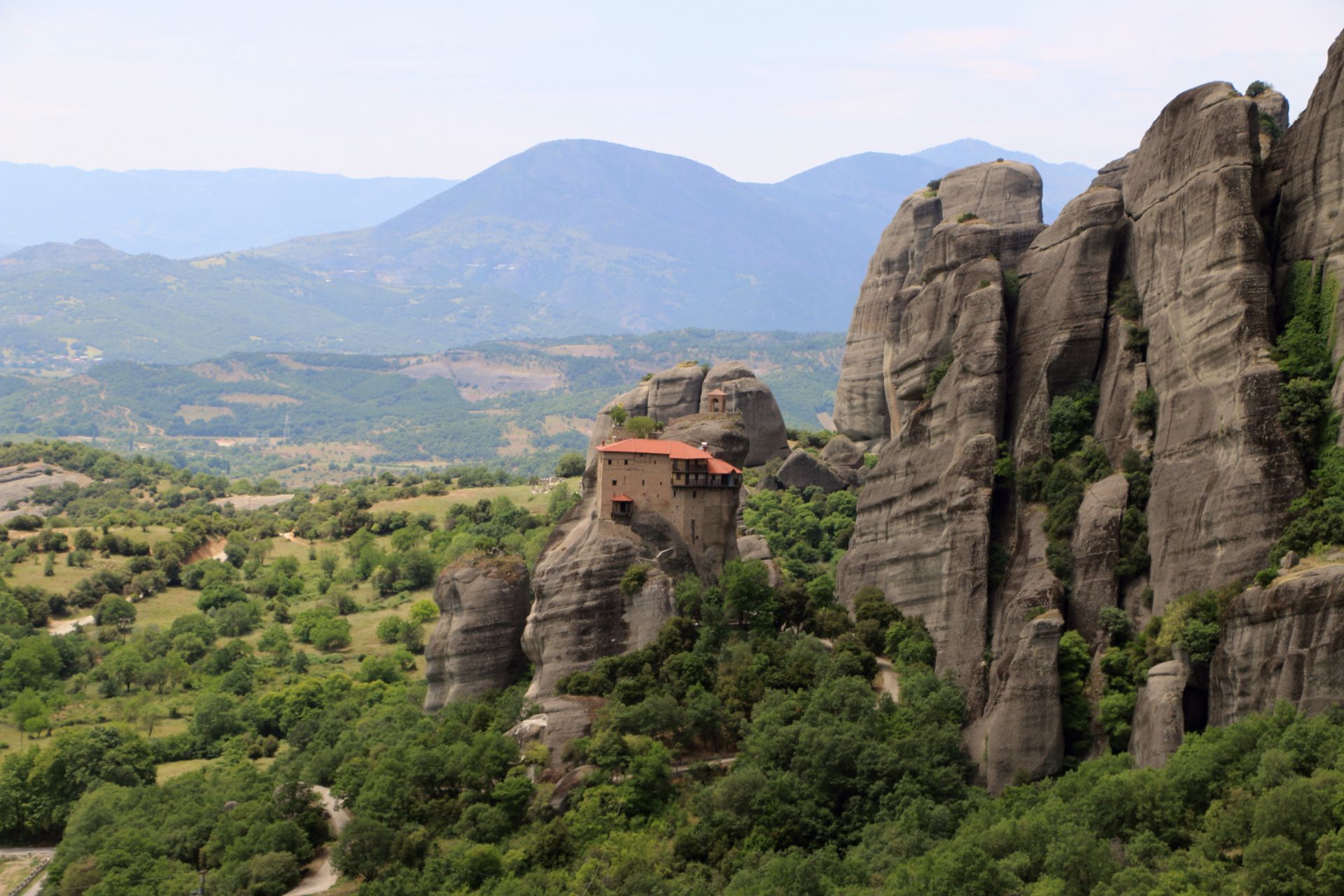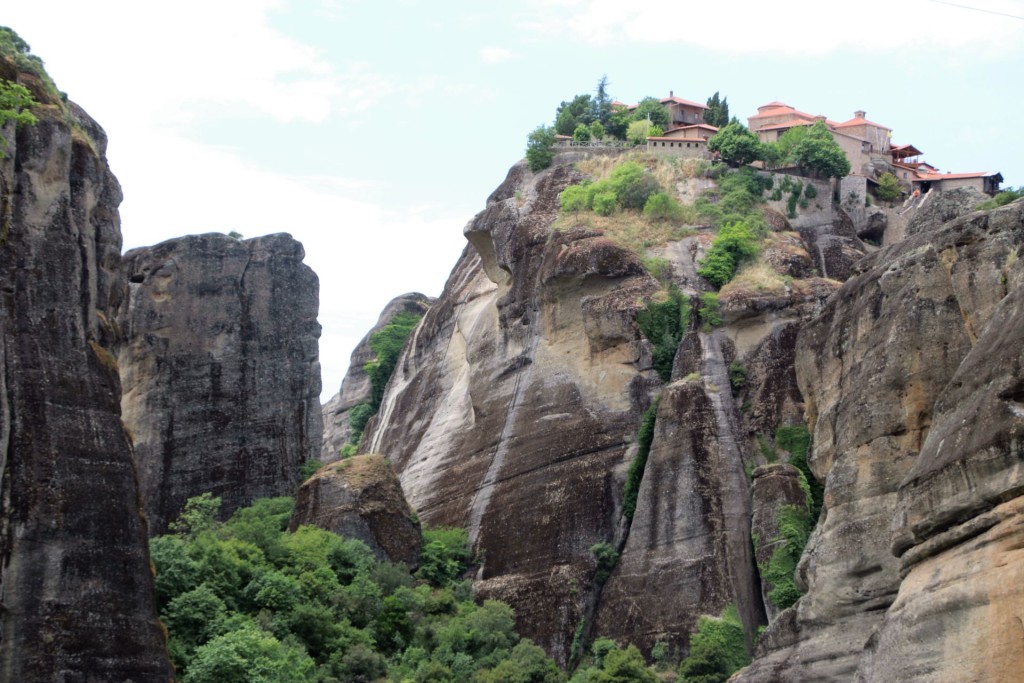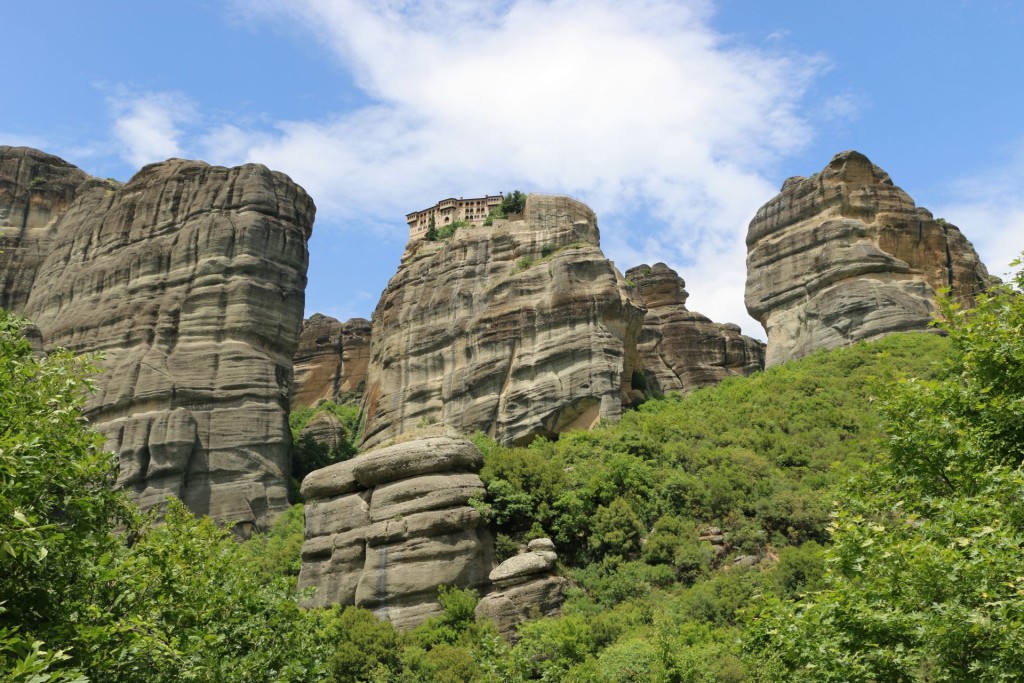 One of the highlights of our last trip through Albania and Greece was a visit to Meteora, a collection of Greek-Orthodox monasteries perched on gigantic 400 meters high rock pillars above the town of Kalambaka. It is no wonder that six (out of the initial number of 24) historical monasteries have been included in the UNESCO World Heritage List and that they are visited by numerous tourists from all over the world.
One of the highlights of our last trip through Albania and Greece was a visit to Meteora, a collection of Greek-Orthodox monasteries perched on gigantic 400 meters high rock pillars above the town of Kalambaka. It is no wonder that six (out of the initial number of 24) historical monasteries have been included in the UNESCO World Heritage List and that they are visited by numerous tourists from all over the world.
Approaching the Meteora after a long drive, we got aware that this is really one of the most spectacular places to visit in Greece: a unique experience of nature’s grandeur in conjunction with history, architecture and the Orthodox religion.
Good hotels and campsites can be found everywhere: we found accommodation at camping Vrachos Kastraki, where we enjoyed a delicious Greek moussaka, while watching the sunset behind the rock pillars.
But let me tell you something about the history of Meteora. Between the 14th and 16th century, the monasteries were built by monks who had lived there as hermits in caves from the 11th century. It took months and years to carry the building material to the top of rocks. The monks used ropes, long ladders, nets and baskets. They liked the isolation and difficulty of access, as this allowed for quiet contemplation and prayer. Of course, the monasteries were also suitable for fending off invading hordes of Turks.
Nowadays, six monasteries are open to visitors (entrance fee: € 3.00). You don’t have to get hoisted up in a basket any more, but getting there is still not so easy, as you have to pass many steps and bridges that were added subsequently. A strict dress code is enforced: shoulders must be covered, men must wear long trousers and women long skirts. Although I was wearing long pants, I had to lend a skirt to cover myself!
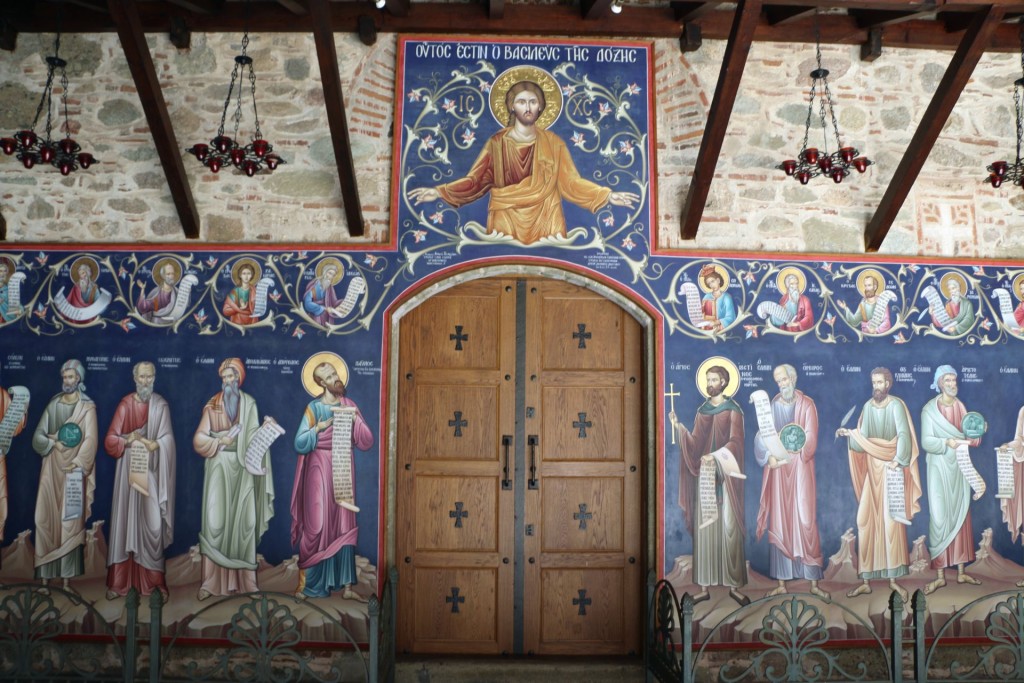 After a quiet night, we got up early to make a round tour of the monasteries on the basis of a good map that was provided by the campsite. But of course, it was necessary to make a choice, as it would have been impossible to visit all monasteries in one day.
After a quiet night, we got up early to make a round tour of the monasteries on the basis of a good map that was provided by the campsite. But of course, it was necessary to make a choice, as it would have been impossible to visit all monasteries in one day.
The first monastery we saw from the road was Agios Nikolaos Anapfasas (photo 1) – in translation: Saint Nicholas the one who rests you. It was founded at the end of the 14th century and has an extraordinary position on the top of a rock pillar.
We decided to pay our first visit to Varlaam, the second biggest monastery, located opposite to the Great Meteoron Monastery. It was founded in the 14th century by Hosios Varlaam (photo 2).
In this monastery we visited the tower from where a net was used by the first monks for their ascent and descent from the rock, until it was “God’s will to have it replaced”! Nowadays, the tower is still used: it was very interesting to see how workers lowered a steel basket for bringing up building materials for the reconstruction works.
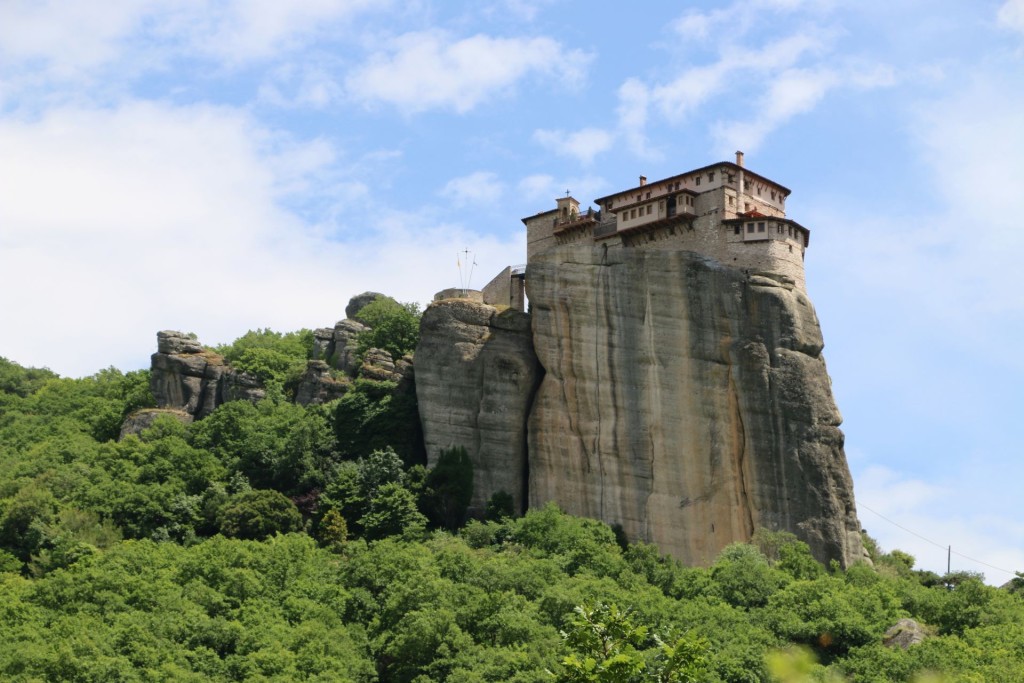 But of course, the most important monastery to visit was the Great Meteoron Monastery or Metamorphosis, which is also the highest and the oldest. Platys Lithos, the gigantic rock on which the monastery stands, rises 615 meters above sea level. That is why it was called the monastery that was “suspended in the air” (meteoro).
But of course, the most important monastery to visit was the Great Meteoron Monastery or Metamorphosis, which is also the highest and the oldest. Platys Lithos, the gigantic rock on which the monastery stands, rises 615 meters above sea level. That is why it was called the monastery that was “suspended in the air” (meteoro).
It was not easy to reach the core of the monastery: we had to pass many narrow steps, first down over a bridge and then up through a stone tower and beside high walls, but finally we were awarded with a fantastic experience. The main cathedral in the central courtyard (photo 3) contained beautiful 16th-century frescoes (unfortunately, it was not allowed to take photos). After visiting the museum with its wonderful medieval icons, we were shocked to see the skulls of former residents, lined up on shelves in the sacristy. The spacious courtyard, full of flowers, offered a divine experience and a rewarding view of the surroundings awaited us on the upper terrace.
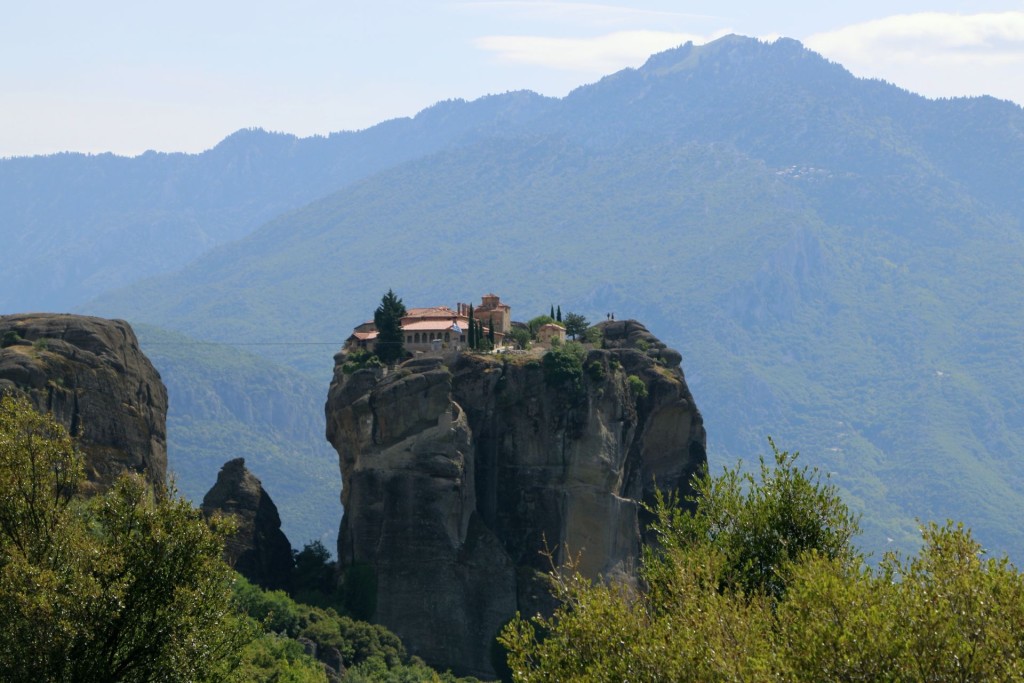 On our way back, we took a look inside the old refectory of the monks and the old kitchen, still black with smoke, with the original bread oven and soup hearth.
On our way back, we took a look inside the old refectory of the monks and the old kitchen, still black with smoke, with the original bread oven and soup hearth.
Continuing our drive, we discovered the Monastery of Roussanou on a lower elevation. It was named after the first probable hermit who settled on the rock. We could not stop admiring the amazing environment, a wonder of nature and architecture. As we had to cross a small bridge from another peak to get to this monastery – we just passed by.
The Agia Triada or Holy Trinity Monastery (photo 4) was founded in the 15th century. It was interesting to read that this monastery was used for the James Bond movie “For Your Eyes Only”. We also skipped the visit of this monastery, as it was very difficult to reach: we would have to walk up 140 steps cut into the rock.
The last monastery we saw on our round trip was Agios Stefanos (photo 5), the only convent in Meteora that has an unimpeded view of the plain towards the town of Kalambaka (the Turkish word for “pinnacle”). Unfortunately, we had spent too much time in the most impressive Great Meteoron monastery (photo 6), so that we were too late for a visit, but we got a good impression of the building from the parking lot.
After all these experiences, our evening was concluded with grilled meat from the campsite’s barbecue with fresh salad and potatoes. The restaurant was full of people who were deeply impressed by their visit of the Meteora. This is really a very special attraction in the northern part of Greece that can be easily reached, also from Montenegro!
